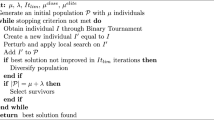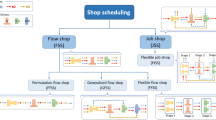Abstract
This paper investigates a preemptive semi-online scheduling problem onm identical parallel machines wherem=2,3. It is assumed that all jobs have their processing times in betweenp andrp (p > 0,r ≥1). The goal is to minimize the makespan. Best possible algorithms are designed for anyr≥1 whenm=2,3.
Similar content being viewed by others
References
He Y, Zhang G. Semi on-line scheduling on two identical machines.Computing, 1999, 62: 179–187.
He Y. The optimal on-line parallel machine scheduling.Computers & Mathematics with Applications, 2000, 39: 117–121.
He Y, Dósa G. Semi-online scheduling jobs with tightly-grouped processing times on three identical machines. Technical Report, Dept. Mathematics, Zhejiang University, 2002.
Chen B, van Vliet A, Woeginger G. An optimal algorithm for preemptive on-line scheduling.Operations Research Letters, 1995, 18: 127–131.
Seiden S, Sgall J, Woeginger G. Semi-online scheduling with decreasing job sizes.Operations Research Letters, 2000, 27: 215–221.
Epstein L, Favrholdt L. Optimal preemptive semi-online scheduling to minimize makespan on two related machines.Operations Research Letters, 2002, 30: 269–275.
Epstein L. Bin stretching revisited.Acta Informatica, 2003, 39: 97–117.
McNaughton R. Scheduling with deadlines and loss functions.Management Sciences, 1959, 6: 1–12.
Epstein L. Optimal preemptive on-line scheduling on uniform processors with non-decreasing speed ratios.Operations Research Letters, 2001, 29: 93–98.
Author information
Authors and Affiliations
Additional information
Regular Paper
This research is supported by the Teaching and Research Award Program for Outstanding Young Teachers in Higher Education Institutions of MOE. China, and the National Natural Science Foundation of China (Grant Nos. 10271110 and 60021201).
Yong He received his B.S., M.S., and Ph.D. degrees all from Zhejiang University in 1989, 1992, 1996, respectively. He is currently a professor and Ph.D. supervisor at Department of Mathematics, Zhejiang University. His current research interests include combinatorial and network optimization, scheduling theory, computational biology, mathematical modeling, etc.
Yi-Wei Jiang received his B.S. degree from Zhejiang University in 2002. He is currently a Ph.D. candidate of Zhejiang University. His current interests include scheduling theory and online algorithms.
Rights and permissions
About this article
Cite this article
He, Y., Jiang, YW. Preemptive semi-online scheduling with tightly-grouped processing times. J. Comput. Sci. & Technol. 19, 733–739 (2004). https://doi.org/10.1007/BF02973433
Received:
Revised:
Published:
Issue Date:
DOI: https://doi.org/10.1007/BF02973433




